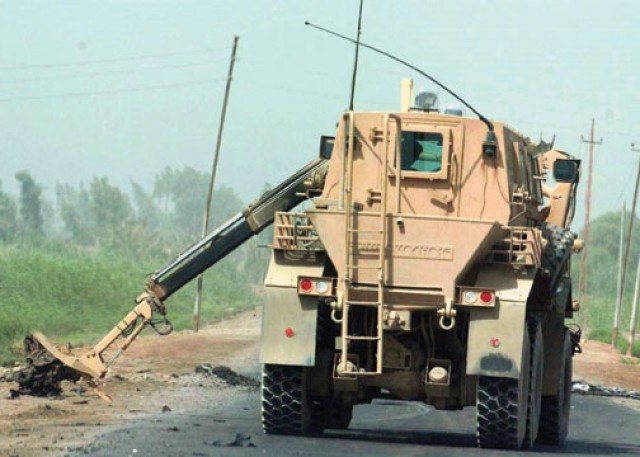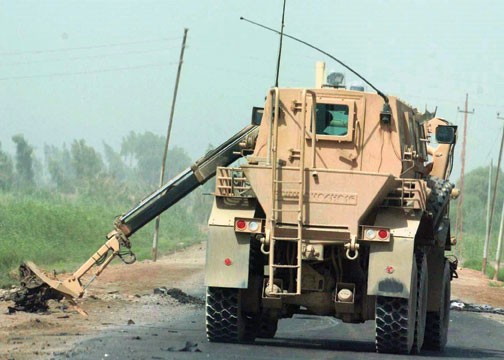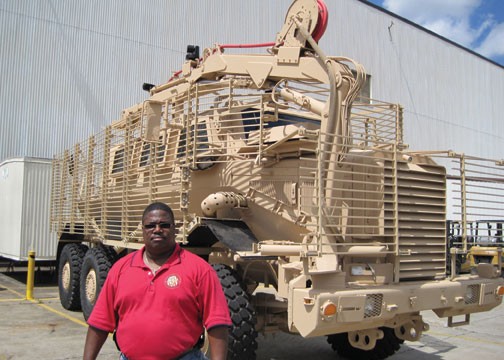Each day across vast stretches of Iraq and Afghanistan, convoys leave the wire with a vital mission: route clearance. Soldiers assigned to this mission work to assure the mobility and resupply of forces. Riding in highly sophisticated and ultra-protected vehicles, route clearance teams go where others fear to tread, deliberately hunting for landmines and improvised explosive devices.
To protect route clearance specialists, the Army fielded the Buffalo Mine Protected Clearance Vehicle, a 13-foot-high, 26-plus-ton monster. This highly specialized, armored, wheeled vehicle's signature feature is a remote-controlled, 30-foot hydraulic arm used to handle suspected explosive devices and execute the delicate work of clearing routes of explosive hazards.
The Army's Product Manager Assured Mobility Systems, or PM AMS, oversees the development and acquisition of the Buffalo and its companion route clearance vehicles. While Mine Resistant Ambush Protected Vehicles and RCVs may look similar and share similar design concepts, the vehicles performing route clearance missions are outfitted very differently to support specific requirements.
By the time MRAPs hit the scene, the Buffalo had been operating in the field for more than three years. In 2002, four Buffalos were deployed to clear Bagram Airfield in Afghanistan. Not long after, the Army was working to find solutions to operational requirements arising from two theaters, while simultaneously managing the ongoing, more deliberate program of acquisition requirements.
The Buffalo program at the Army's Product Manager Assured Mobility Systems (which overseas development and acquisition of both the Buffalo and RCVs) has been very stable, with the same team directing both operational development and integration efforts since June 2005, and acquisition efforts since October 2006, when the Army formally approved the MPCV requirement. Testing for the Buffalo A2 began in September 2008.
The Buffalo's roots are found in the 1966-1989 South African Border War in Namibia. In that conflict, Soviet and Cuban landmines posed a lethal threat to South African troops along the Angolan border. Because of its policy of racial apartheid, the world had isolated the South African government, requiring it to develop its own solutions to military problems.
To combat the landmine threat, South African engineers looked at lessons learned by the Rhodesian military and designed armored vehicles with V-shaped hulls to deflect the force of an explosion around the crew compartment. Some of these vehicles, such as South Africa's Nyala, are the forerunners to the RG-31, a 4x4 multi-purpose mine-protected armored personnel carrier. The South African Casspir was used for mine detection during peacekeeping missions in Bosnia-Herzegovina in the late 1990s.
By 1999, under the auspices of the Ground Standoff Mine Detection System program, the Army began foreign comparative testing of two South African vehicles-the Casspir and the Lion II-to determine which would serve as the basis for the GSTAMIDS vehicle. In early 2001, the Army selected the Lion II, which, with further engineering development and design modifications, became the Buffalo A0.
The Buffalo's early success in Afghanistan in 2002 made it the logical choice when IEDs became a threat in Iraq. The GSTAMIDS program team was "on to something," said former PM AMS Deputy Dennis Haag. "If it could find mines, it could find an IED." As a result, the Army rushed its sparse route clearance equipment into Iraq and began procuring more early in the war.
With a small, handpicked team, PM AMS set to work designing vehicles that met battlefield requirements. Developing a new vehicle is a daunting task in peacetime, but the added pressure of war on two fronts motivated the team to often work 16 hours a day, six or seven days a week. Soldiers were in harm's way, and the team needed to deliver.
The PM AMS team repeatedly traveled to Iraq during December 2005 to observe the vehicles in operation. While there, Haag spoke with Soldiers to see how they used the Buffalos during route clearance operations. The Soldiers quickly realized the PM AMS team had the ability to deliver a vehicle tailored to their requirements. They began feeding the team a stream of useful suggestions as route clearance methods had to continually evolve to defeat an ever-changing threat.
A former member of the GSTAMIDS team explained that more than 25 add-on capabilities have been integrated into the Buffalo, including fire suppression, additional armor, an air digger and other survivability capabilities.
"When this effort was initiated, we hadn't been in touch with the user," Haag said. "No one had really sat down with the Soldiers on the ground."
Spending time with the end-users in real-world conditions changed that. Haag's copious notes, based on Soldier input, influenced the evolving design of the Buffalo and other RCVs and served as a baseline for production requirements.
The Buffalo program has led the way in developing solutions that apply to a wide range of vehicles. In 2004, the Buffalo was the first vehicle outfitted with bar armor, an upgrade to slat armor, which helps protect against rocket-propelled grenades. When explosively formed penetrators emerged as a threat, the Buffalo EFP kit was the starting point for EFP protection kits designed and installed on a range of MRAP vehicles.
Soldiers on the ground understand and appreciate the numerous cutting-edge protective capabilities of the Buffalo. Staff Sgt. Ryan Grandstaff, who performed route-clearance missions with the Ohio National Guard's 612th Engineer Battalion, told CBS News in 2005 that the Buffalo made him feel "100 percent safe," adding, "I've been through countless explosions, and I'm still here to tell about it."
So far, the Army has fielded 215 Buffalo MPCVs in three configurations (models A0, A1 and A2) in support of operational requirements, and continues to execute the acquisition of the Buffalo A2 vehicle, which will become a permanent part of route-clearance companies in the future. The Buffalo A2 features a host of add-on and field-identified improvements incorporated by the program management team. The goal is to complete all requirements to earn full materiel release by the end of 2010. Once testing is complete, PM AMS will begin the process of bringing all the vehicles in the field up to the final A2 configuration.
As a nonstandard vehicle, the Buffalo requires the use of contractor logistics support to keep it running. When the Buffalo A2 earns its full materiel release, it will be supported by the Army's own logistics systems. Army mechanics will learn how to maintain and repair the new vehicle, moving the maintenance mission in-house.
The Army hopes to procure 372 Buffalo A2s for use in engineer route clearance companies, brigade route clearance platoons, and maneuver training centers such as the Maneuver Support Center of Excellence at Fort Leonard Wood, Mo.




Social Sharing